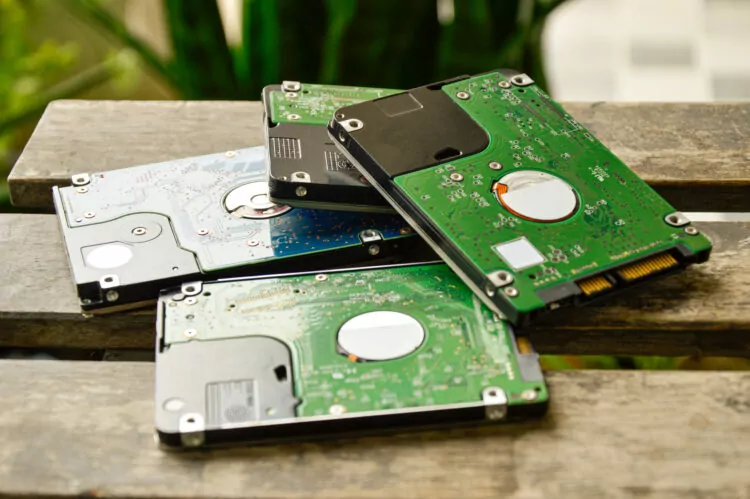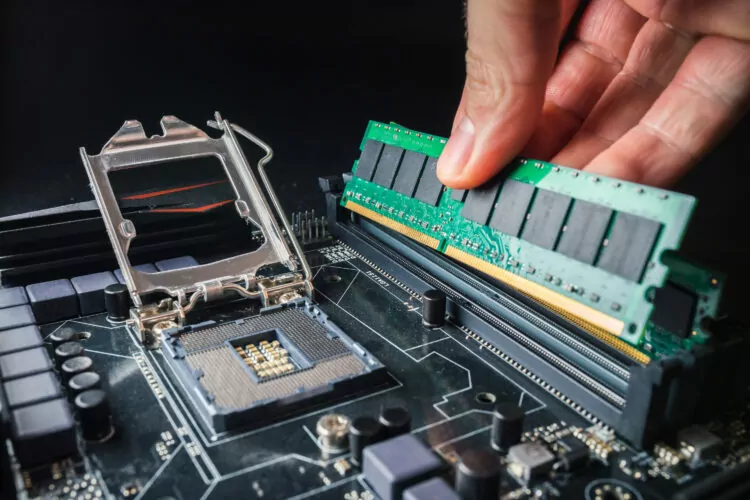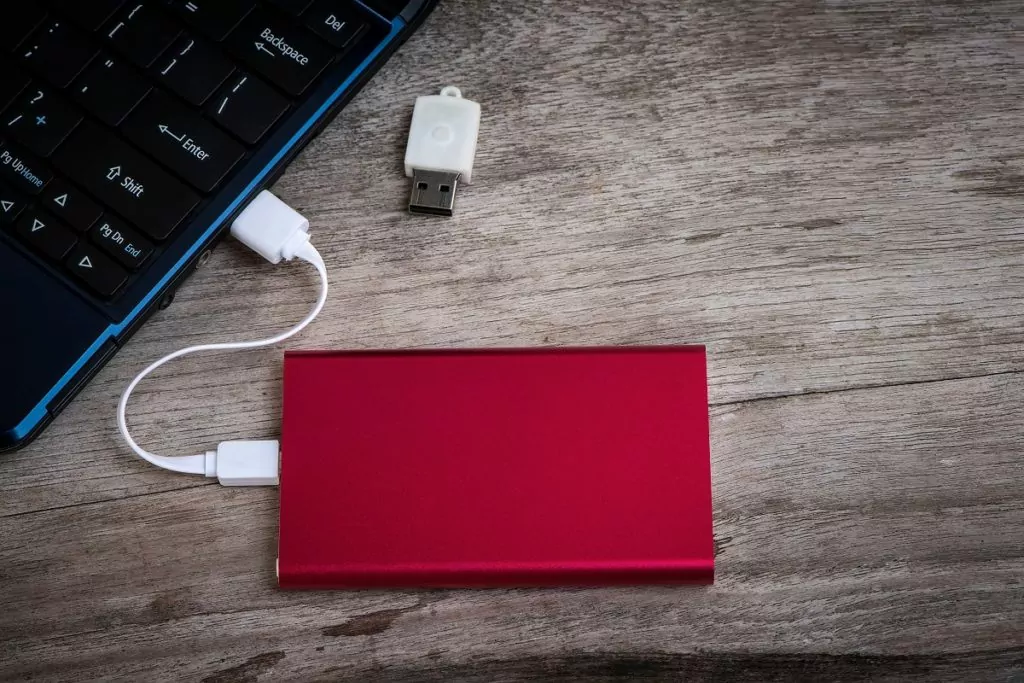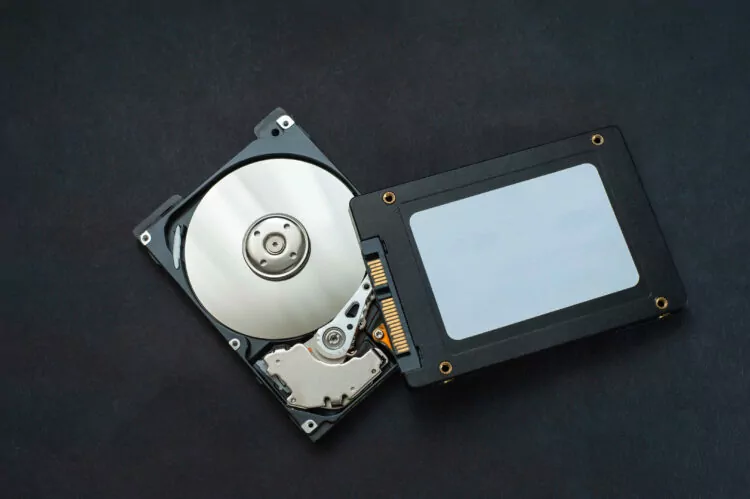Here’s everything about your computer slowing down if your data storage (HDD, SDD, NVMe) is full:
Yes. No matter what kind of device your computer uses for its primary data storage, if that storage is full enough, it will bog down your computer’s performance.
In extreme cases, your computer will slow down to a point that makes it feel completely unusable.
Fortunately, there are remedies to the problem.
So if you want to learn all about how full data storages slows down your computer, then this article is for you.
Keep reading!
- M.2 NVMe SSDs: Two or More Affect Performance?
- Sophos Slows Down Computer: True?
- Trend Micro Slows Down Computer: True?
- Rainmeter Slows Down Your Computer: True?
- Computer Flops Calculating: How Many?
- Computer Idle Memory (RAM) Usage: How Much?

Why Does Full Data Storage Slow Down Your Computer? (3 Reasons)

Typically speaking, computers use one of three types of devices as the main storage drive for the operating system and all of the critical information that they need to function.
Those are hard disk drives (HDDs), solid-state drives (SSDs), and non-volatile memory express drives (NVMe).
Each drive works on different core principles, but any can serve as the main drive for a computer.
When the main drive is full, things slow down.
That is true no matter what kind of drive you have, so moving forward, let’s keep things simple.
I’ll refer to all three of these types of devices as drives, disk drives, or storage drives for the rest of this conversation.
With that covered, let’s jump into exactly how a full drive makes a difference.
#1 Virtual RAM

One common way a full drive will inhibit computer performance is by limiting the use of virtual memory (or RAM).
Before we can get into that, it probably helps to explain a little bit about computer memory.
Your computer has specialized modules on it that serve as Random Access Memory (RAM). These modules temporarily store information that your computer’s processor needs in order to function.
So, if you try to check your email, the RAM will store files that help that program function.
When you’re done checking your email, the RAM will empty those files to make room for new temporary files that help the next thing your computer is doing.
A computer can only hold so much physical memory, so what a lot of programs do is make use of something called virtual memory.
This is where your disk drive (whether HDD, SDD, or otherwise) offers up some of its free space to the computer, and that free space can be used in a way similar to that of RAM.
It bolsters the amount of information that can be kept available for the RAM, and it can help the computer run faster.
If your drive is full, then there is no free space to use for virtual RAM. Ultimately, that makes the computer run slower.
By the way, learn all about how much RAM your computer should use when it’s idle here.
#2 Finding Files

On a completely different note, having more information slows the computer down by making the processor work harder.
It’s pretty simple.
In order to do something, a computer has to call up the right files and execute them.
Finding those files takes longer when there is more information to sift through.
Now, modern devices are pretty good at organizing information on a storage drive, so it’s not as big a deal as it used to be, but it can still impact performance.
You can think of this with a file cabinet analogy.
If you had to find a specific document in a filing cabinet, it’s going to be a lot easier if most of the cabinet is empty.
That’s true even if everything is organized pretty well.
#3 Making Room for Information

Mostly, it actually comes down to temporary folders on the computer and making room for new information.
Let’s kick this idea off with a different analogy.
Picture a storage unit.
It is filled from wall to wall and floor to ceiling with stuff. There is no room for anything else.
If you want to get a specific item out of that storage unit, it’s hard because you can’t shift things around while you look.
Instead, picture a unit that is only half full.
In this case, if you want something from the back, you still have to shift things around, but there’s enough room in the unit to do that, so it’s easier to find what you want.
The easiest way to understand how this impacts a computer is to look at temporary folders for an operating system.
In order for the operating system to do the things it needs to do, it constantly has to create temporary files.
These files come in all kinds of varieties, but they are created at the moment to customize operations.
Once everything is done, the files can be deleted, but they are usually kept around until the next restart, just in case the computer needs to access them again.
Now, if your disk is completely full, the operating system can’t create a temporary file that it needs.
Instead, it has to find space on the disk, and that usually involves deleting something else.
So, the operating system might be able to delete a different temporary file, but until it can, whatever you’re trying to do is paused to make room for these necessary files.
You can see how that creates a bottleneck that slows things down.
Depending on how fast or slow your storage drive is, this can become a painful process.
In any case, a computer slows down considerably when it can no longer freely make temporary files.
How Much Space Do You Need on Your Computer?

Ok. A full drive slows things down.
That’s easy enough.
But, how full is too full?
When do you really expect to see performance issues from a full drive?
Each device and operating system will be a little different, but the general rule is that 10% of a drive should always be left empty.
In most cases, that’s enough extra space for all of the important functions that help your computer run fast.
More specifically, modern operating systems keep track of this.
If your drive gets too full, the system will send you a warning message.
If you get such a message, then you need more storage space.
How Do You Free Up Disk Space on Your Computer? (5 Methods)

So, what happens if you fill up your disk drive?
Sure, the computer will run slowly, but is there something you can do about it?
The good news is that you can always get more disk space, and you have a few options about how you do it.
You can try to add more storage devices to the equation, upgrade the hardware you are using, supplement with remote resources or delete things from the full drive.
#1 External Drives

One of the easiest things you can do is grab an external drive and transfer files to it.
You can use a thumb drive, external hard drive, or any other external media storage that you like.
The idea is to copy data from the internal drive to the external drive.
Once you do, delete the copy that is on the internal drive. This frees up space.
If you’re worried about an external drive failing, then you should make multiple copies.
IT experts usually work by a rule of three.
Any information that you can’t afford to lose should have three existing copies, and ideally, one of them should be on a cloud server (more on that later).
You can even play games from an external drive.
There isn’t even much of a performance difference when you play games from an external drive instead off your internal drive.
#2 Removing Software

If the use of external drives isn’t practical or sufficient for your case, then you can look at removing the software.
Modern software tends to be the biggest source of data storage hogging that you will find.
Whether it’s productivity software, computer games, or anything in between, they’re known to eat up multiple gigabytes of space each.
If you have any software that you can afford to ditch, go ahead and remove it.
If you’re worried that you might need the software later, then what you can do is save the user settings and data.
Many applications, when you delete them, will ask if you want to keep your user data. Go ahead and say yes.
This way, if you reinstall the software later, it will be able to pull up your old information.
But until then, the software itself usually takes up a lot more storage space than the user data attached to it.
#3 Expanding Internal Drive Space

Especially if you want to expand your virtual memory capacity, increasing internal drive space is one of your best options.
With desktop PCs, you can typically install more than one storage device in the system.
So, you can have more than one HDD, SDD, NVMe drive, or mix and match them.
That makes it easy to expand your storage space, and everything is still right there on the computer.
With a laptop, you might instead need to upgrade the size of the storage device.
Instead of adding a second drive, you replace the existing drive with something that can hold significantly more data.
Keep in mind that this works best when you have the resources to clone the original drive.
This is a technique that perfectly copies everything from one drive to another.
The technique prevents you from having to install your operating system or other software on the new drive after it is installed.
Instead, you can complete the cloning process, swap the drives, and you’re good to go.
If you’re not comfortable doing this, you can always enlist the help of an IT professional.
#4 Going to the Cloud

Instead of plugging external storage devices into your computer, you can make use of the internet.
Cloud services can hold a bunch of data off of your computer.
As long as you have access to the internet, you can get your data whenever you want.
Cloud services come in all shapes and sizes.
Find the one right for you.
If you have a lot of photos, then a photo-based cloud solution is probably the most efficient.
If you share a lot of work files, something akin to Dropbox might be the way to go.
There are many options.
You are going to be weighing service fees against the amount of storage you get and how easy it is to use that storage.
#5 Just Deleting Stuff

After all, is said and done, the goal here is to free up space on your drive.
You might find that the easiest thing to do is to find files that you won’t miss and just delete them from the computer. It’s fast and easy.
For temporary relief, you can also go through the temporary file folders on your computer and empty them.
This can buy you a little extra space that might speed up the process of copying or emptying the drive as part of a more complete solution.
At the very least, you can use this idea in conjunction with any of the methods above.

